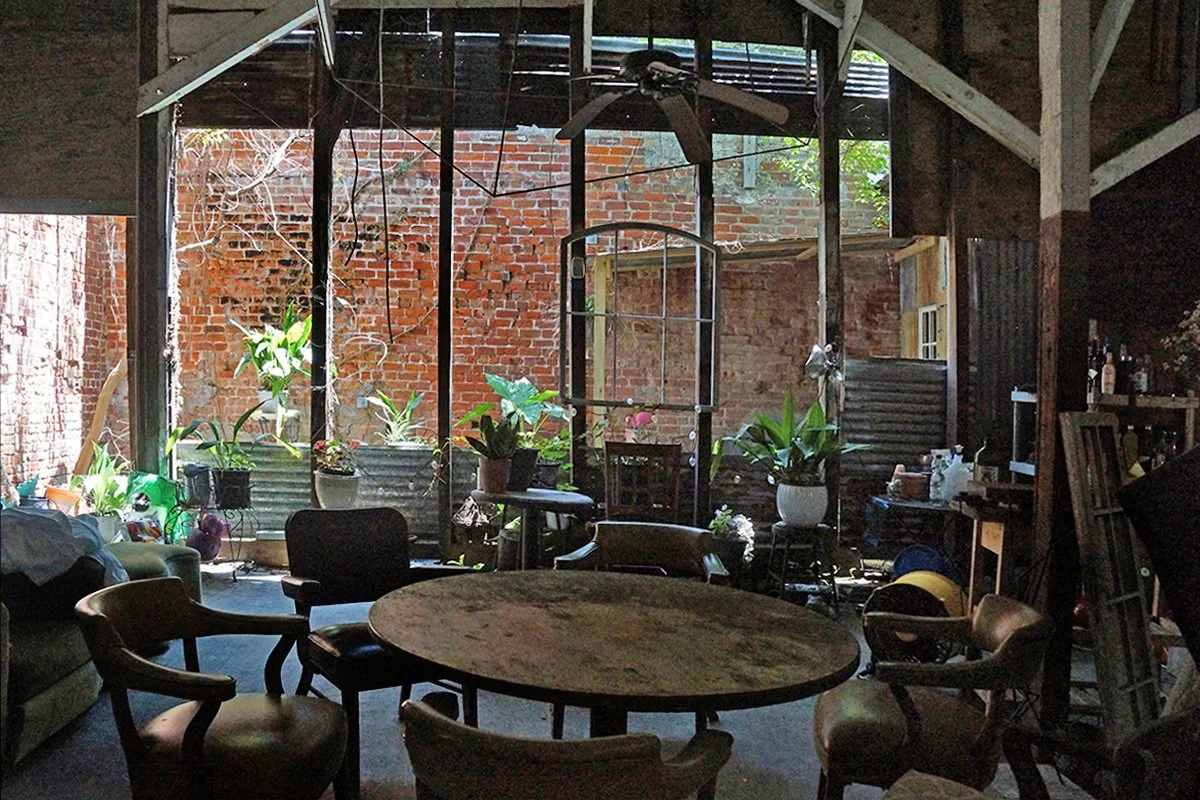A Palette of Place: Michalopoulos’ Hotel Pompadour
One of the second-floor rooms in the new Hotel Pompadour
May 2025This new boutique hotel in the Marigny is as colorful and memorable – and unexpected – as a painting by its artist owner, James Michalopoulos.
– by Kim Ranjbar
photos by Ellis AndersonThis column is underwritten in part by Karen Hinton & Howard Glaser
In contrast to the ubiquitous grays, browns and beiges that dominate swaths of suburban landscapes across the country, the architecture of New Orleans is a kaleidoscope of color. Long before the city's post-Katrina explosion of vivid hues, it already boasted a palette all its own – one uniquely captured in the impasto-rich paintings of James Michalopoulos.
The local luminary, oft-imitated and well-known for his impressionist portrayals of New Orleans homes and cityscapes forever in colorful motion, recently opened a 12-room boutique hotel in the Faubourg Marigny.
Several rooms in the new Hotel Pompadour open into an expansive and playful courtyard
A project nearly a decade in the making, Hotel Pompadour is a “sortie into the marvelous and complex world of the Marigny and the French Quarter,” says Michalopoulos. “We offer a dose of our way of looking at the world and our culture.”
A free spirit devoted to preserving the arts and the bohemian character New Orleans has long embraced, James Michalopoulos is constantly immersed in artistic projects across the city. From designing an affordable artists’ village in the Upper Ninth Ward to creating collectible posters for the New Orleans Jazz & Heritage Festival and Greek Fest – and now the subject of a WLAE/PBS documentary, Michalopoulos: The Art of Celebration – his latest endeavor, the vibrant Hotel Pompadour, is yet another colorful creation in motion.
Artist James Michalopoulos at the hotel’s entrance on Elysian Fields
Asked how the hotel came to be named after a hairstyle trend which originated in the late 17th century in the royal court of France, Michalopoulos said, “I don’t really know how the hell I came up with it. I tried a few other names that were protected or in one way or another contentious. But we have somewhat of a French affliction and for me, the pompadour is a French name suggesting luxury and excess.”
When Michalopoulos first purchased the cluster of buildings on Elysian Fields Avenue in the early 2000s, it had been sitting vacant for decades. In a space referred to as “the barn,” the artist carved out an expansive, open-to-the-elements studio.
Michalopoulos’ studio, next door to Hotel Pompadour
Michalopoulos’ studio, next door to Hotel Pompadour
James Michalopoulos in his studio
Originally built in the later part of the 19th century, that studio building stands on the site that was once Bernard De Marigny’s lumber mill, which supplied wood to build homes in the French Quarter, Marigny – and later the Bywater.
“Back then Elysian Fields was a waterway. They would go up to the Gentilly forest to harvest the wood from there and a barge would bring it down to the mill,” explains Tatianna Macchione, Director of the Michalopoulos Gallery and Foundation.
Later, the site on Elysian Fields Avenue became home to Phoenix Stables, a livery and undertaking business owned and operated by coroner John Grayer. Then in 1885, the entire property was purchased by Greek immigrants Henry Frantz and Jacob Schoen, a precursor to what is now Jacob Schoen & Son, Inc., an extant family-operated funeral home.
Back then, a row of three townhouses extending to Chartres Street was built next to the stable or “barn.” By the time Michalopolous acquired the property, only two remained. The Hotel Pompadour and its large front courtyard (formerly a parking lot) were creatively and colorfully re-constructed from these surviving townhouses.
The enormous courtyard at Hotel Pompadour
Vestiges of the Schoen’s long-running funerary business remained before construction on the hotel began. Michalopolous’ current studio was where the horses and vehicles used to pull hearses were kept, and the adjacent townhouses were partitioned into offices, casket displays and reposing rooms.
“There were lots of bathrooms and chandeliers everywhere … just so many chandeliers,” recounts Macchione. “All of those chandeliers have been reincorporated into the project.”
One of the chandeliers illuminates the front desk.
Michalopolous’ artist’s perspective guided this multifaceted historical renovation, respecting the remaining materials and preserving as much as possible.
“James was being mindful of sustainability and wanted to save as many of the original materials as possible,” explained Macchione. “If you go a little slower, you’re able to conserve more.”
The hotel was indeed a long time coming, since the first architectural concepts were drawn up in 2017 by Rick Fifield, a local, award-winning architect with a passion for historic conservation. After the permits were acquired, the construction was well underway when the pandemic hit, pausing the entire project for the foreseeable future. Even after construction started a few years later, led by contractor Andrew Williams and foreman Yelsin Martinez, the pace of construction was still slow and measured.”
“There was always this question of how much we could save, a respectful conversation between us, the builder and the building,” says Macchione.
“The building has a voice and it’s had this very long history, and it took time to uncover the story that this building had to tell.”
Many structural features remain from the old hardwood floors, and exposed brick and woodwork to both of the townhouses’ original staircases, now highlighted side by side in the Hotel Pompadour’s front lobby.
A difference of over a foot in floor height separated the two townhouses, but precise accommodations were necessary to meet the Louisiana Division of Historic Preservation’s expectations. “We’ve really tried our best to maintain and keep as much of the historic fabric that was originally there, not just cover up all of the different layers,” says Macchione.
One of those layers includes a double-thick concrete block wall running down the Chartres Street side of the hotel which was built sometime in the 1930s.
The courtyard’s whimsical sculptures give the space a playground feel.
One of the windows opening into the courtyard.
“When we cut into that, we got a 20 inch [deep] window,” explained Macchione. “But it’s so different and interesting looking. It [the building] had been in commercial use for a long time.”
Starting with the original plan drawn up by Fifield and his associate Michael Murray, the design of Hotel Pompadour was constantly changing. When they decided to make it a historical project, discoveries were made while trying to uncover the original structures that would alter their plans.
“We really never stopped designing. We let the building dictate a lot of it, which was one of James’ main objectives – what is the spirit of the building. It’s what he’s always trying to capture in his artwork.”
The interior courtyard at Hotel Pompadour
Playful elements in the inner courtyard of Hotel Pompadour
In combining the hodgepodge of architectural features into one contiguous whole, they created a hotel made up of a series of unique rooms, each one different from the last. Michalopoulos’ paintings – which are hung in every room, hallway and shared space – are the sole unifying element. The gallery team, led by curator Julie Connelly-Nicoll, and including Bogdan Mynka and Bijoux Wilson, were instrumental in curating the work and arranging the spaces.
Even the furniture reflects the hotel’s bohemian nature, a wildly eclectic collection the artist gathered over the years from antique stores and estate sales across Louisiana.
“James bought most of the furniture before the construction was done. Most of it was cookie jars,” jokes Macchione. “He just started filling up his studio with wonderful pieces over time, all of it local, with a couple of pieces from his own collection from his travels over the years.”
One of the common rooms at Hotel Pompadour
The colors selected throughout reflect the spirit of Michalopoulos’ art, influenced by the shifting quality of light in each room. During his annual retreat to his studio in Burgundy, France, James entrusted Macchione with the task of curating the hotel’s interiors.
Though deeply familiar with the vivid, moody hues characteristic of Michalopoulos’ work and already envisioning a palette for each space, Macchione also sought the expertise of historic preservationist and color consultant Elizabeth Simpson, of Studio Patina.
One of the ground floor rooms with windows overlooking the courtyard.
“Tatianna was really the starting point for each room and I was a sounding board,” said Simpson. “She has this beautiful sense of color and taste, and she was coming at it from a scientific view in some ways – you know this room faces east, this faces west, this has a warm light or a cold light. That was really interesting because I’d never had a client who took it that far.”
Simpson and Macchione had an ongoing dialogue, shading room by room (inspired by a Farrow & Ball palette), thoughtfully and intentionally evoking the spirit of each space through color and light.
In a second-floor suite known as "The Orleania" where west-facing, floor-to-ceiling windows welcome the afternoon sun, the burgundy sitting room glows with warmth. A round-topped door framed by bold, stepped molding in a deep, dark blue anchors the luminous space.
The Orleania suite
Another guest room, fittingly named “Dutch Orange,” is one of two showcasing curved custom-built bathrooms. Painted bright orange, the bathroom wall offers a sharp contrast to the marine blue color of the room, trimmed in natural wood moldings and exposed ceiling beams.
The Dutch Orange room
“On that [orange] wall, we probably tried about ten different colors before we found the right one,” laughed Simpson. “It changed so much and had so many angles!” The design anchor that kept them grounded was “ultimately, what do we want this space to feel like.”
The banks of time, talent and effort invested through the years shows: Hotel Pompadour feels as though you've stepped into one of Michalopoulos’ vibrant paintings. On the website, it’s accurately described as a “love letter to the Faubourg Marigny, one of the last bastions of bohemian culture in the country.” Every detail shines. Eccentric curios and bric-a-brac give the impression you're visiting a friend's home – albeit a friend with a deep passion for art.
“It’s a way for us to honor people, honor the city and honor our guests. That’s what we enjoy doing. We enjoy creating welcome,” says Michalopoulos.






















